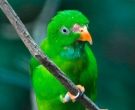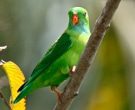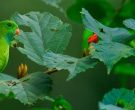Content |
|---|
Description
Solo 14 cm.. length and 28 g. of weight.
The head of the Vernal hanging parrot (Loriculus vernalis) is bright green, lighter and more yellowish in the chin. Rest of the upper region green, with the bottom of the back, rump and upper coverts bright crimson. Wing coverts a little darker than the the mantle green. Primaries bright green with vane inner blackish and a light blue-green diffusion in the feathers of the vane outer; secondaries Black with exterior bands of green and a bit of green in vane inner. Under the wing
a brilliant turquoise blue, except coverts and axillary, that are pale green. The underparts more greenish-yellow that the upperparts, with a patch light blue in the throat. Upper, the tail green; Turquoise Blue below.
Bill coral red with yellow tip: irises Brown to yellowish-white; the legs they pale brown to yellowish Orange.
The females they are slightly more off than males and have a patch blue in the throat less extensive.
The young birds lack of the patch blue in the throat and have a bill paler, the rump narrow and green feathers of the tail and legs brown.
The young birds they need at least a year to mature.
- Sound of the Vernal hanging parrot.
Habitat:
Some movements, possibly related to seasonal rains, have been observed, but they require further study. The species is found in a variety of habitats, including Evergreen deciduous forests and, next to clear forest, secondary growth, bamboo thickets, orchards and too grown crops, up to approximately 2.000 m.
The birds are found in pairs, family nuclei, loose herds of up to 50 individuals or groups mixed with other birds. Their size and coloration make it a discrete ave, but they are not shy and can be found feeding in the canopy, Sometimes the attention of an observer with short flights and circular around the tops of the trees.
Jump between the branches and climb swiftly using both beak and legs, sometimes form 'spirals'’ to ascend. Lie, They groom and sleep strung upside down one or both legs, Although juveniles may remain in vertical position, scratching your head over the wing.
Reproduction:
Like the Lovebirds, cut small strips of bark, leaves and other plant materials, they put them in the contour feathers and carried them to the nest as an overlay. The breeding occurs between January and April; between two and four whites, often spotted brown eggs, they are deposited in the cavity of a rotten trunk. The narrow entrance is sometimes enlarged by birds, and the deep hole can extend below the ground level in exceptional cases.
The incubation, that lasts around 22 days, It is carried out by the female. The male helps feed the chicks as they mature over a five-week period..
Food:
They feed on acrobatic form of nectar in the trees in flower (for example, trees of Coral Erythrina) and in fruit trees especially figs Ficus or guava (Psidium guajava), as well as various berries and plant species such as bamboo and casuarina. Also consume collected potted Palm wine, and they can then take, and damage to orchards.
Distribution:
Size of its range (reproduction / resident): 6.460.000 km2
widespread, from the West coast of the India some 19 ° Norte, through at least Maharashtra, Madhya Pradesh, Karnataka, Kerala, Tamil Nadu, Andhra Pradesh, Orissa, West Bengal, Assam, Nagaland, Manipur and Tripura, and is also distributed in the Andaman and Nicobar Islands. In Nepal is distributed in small amounts in the lowlands of the Terai , and also have been in the area of Chitwan.
Observed in Bhutan; Southwest of Sichuan through Yunnan, and possibly in Kwangtung, in China; Sylhet, Quotation mark and Chittagong in Bangladesh; Myanmar including the Mergui archipelago: Thailand Around South of 10 ° Norte (also observed to the South, on Phuket Island); Laos; Cambodia; and Viet Nam. The species has not been recorded in Sikkim, Hong Kong and Malaysia.
Conservation:
• Current IUCN Red List category: Least concern
• Population trend: Stable
The size of the world's population has not been quantified, It is thought that it may be above the 1.000.000 of copies. The species according to information, is very rare in China, in general, common elsewhere (pit et to the. 1997).
The population is suspected to be stable in the absence of evidence of any reduction or substantial threats.
"Vernal hanging parrot" in captivity:
Limited number in captivity
Alternative names:
– Vernal Hanging-Parrot, Indian Hanging Parrot, Indian Hanging-Parrot, Indian Lorikeet, Vernal Hanging Parrot (ingles).
– Coryllis vernal, Coryllis d’Inde, Loricule vernal (French).
– Frühlingspapageichen, Frühlings-Papageichen (German).
– Lóris-indiano (Portuguese).
– Lorículo Vernal (español).
scientific classification:
– Order: Psittaciformes
– Family: Psittaculidae
– Genus: Loriculus
– Scientific name: Loriculus vernalis
– Citation: (Sparrman, 1787)
– Protonimo: Psittacus vernalis
Vernal Parrot Images:
————————————————————————————————
Vernal hanging parrot (Loriculus vernalis)
Sources:
– Avibase
– Parrots of the World – Forshaw Joseph M
– Parrots A Guide to the Parrots of the World – Tony Juniper & Mike Parr
– Birdlife
– Photos:
(1) – “Loriculus vernalis-Ganeshgudi, Karnataka, India-male-8-1c” by Loriculus_vernalis_-Ganeshgudi,_Karnataka,_India_-male-8. jpg: viwakederivative work: Snowmanradio – This file was derived from:Loriculus_vernalis_-Ganeshgudi,_Karnataka,_India_-male-8. jpg . Licensed under CC BY-SA 2.0 via Wikimedia Commons.
(2) – “Vernal Hanging Parrot” by Jason Thompson – Flickr: Vernal Hanging Parrot. Licensed under CC BY 2.0 via Wikimedia Commons.
(3) – By viwake [CC BY-SA 2.0], via Wikimedia Commons
(4) – A male bird – Author vasanthan.p.j – lynx
(5) – “Loriculus vernalis-Prague Zoo, Czech Republic-male-8a” by Jozef Murgaš – ZOO Praha 34Uploaded by snowmanradio. Licensed under CC BY-SA 2.0 via Wikimedia Commons.
– Sounds: Mathias Ritschard (Xeno-canto)





